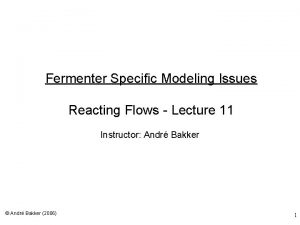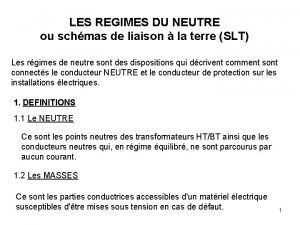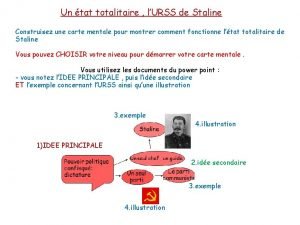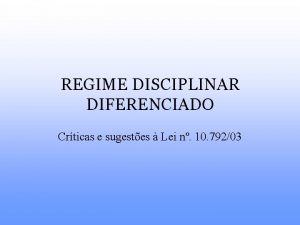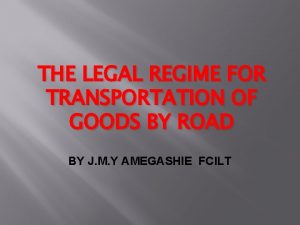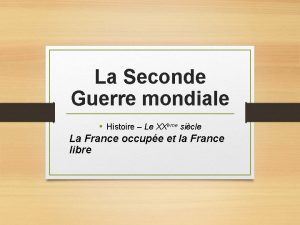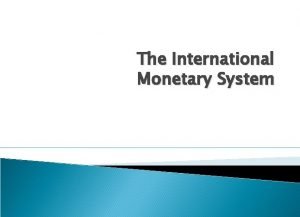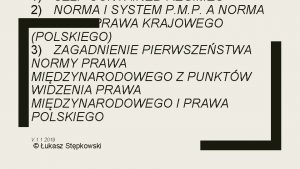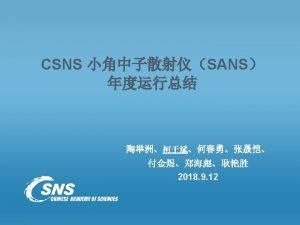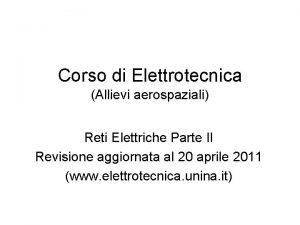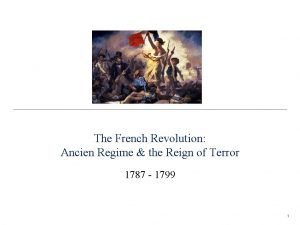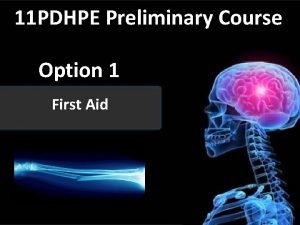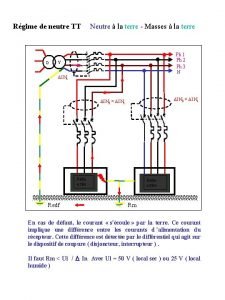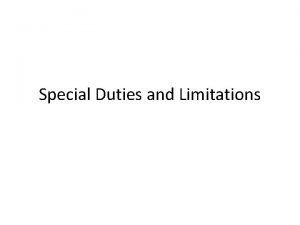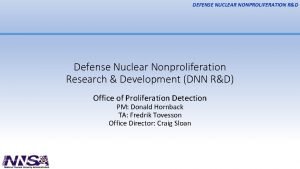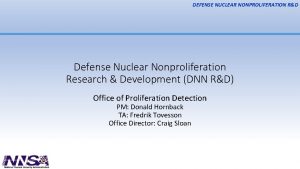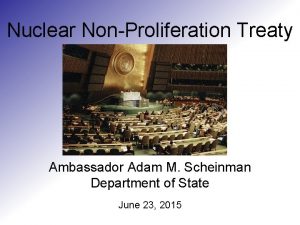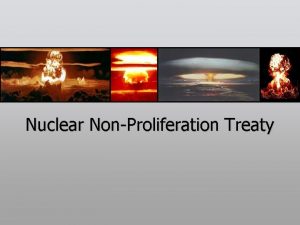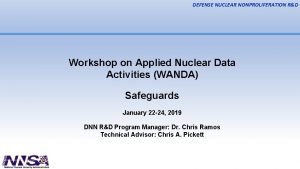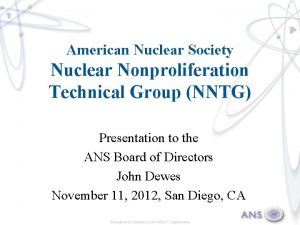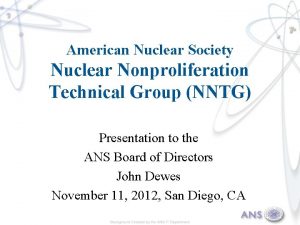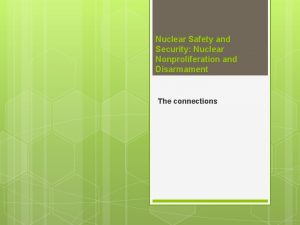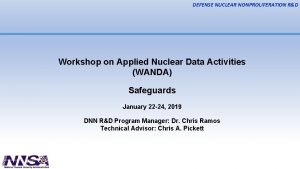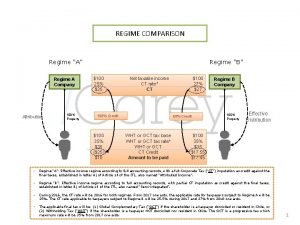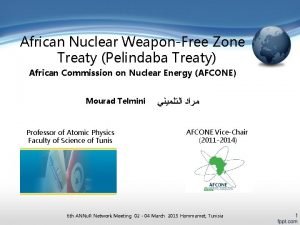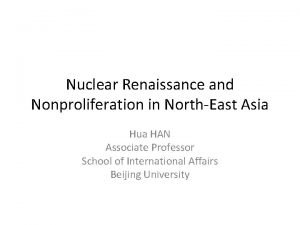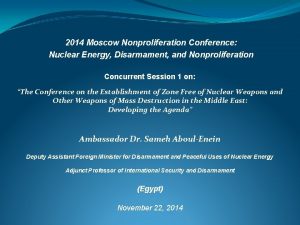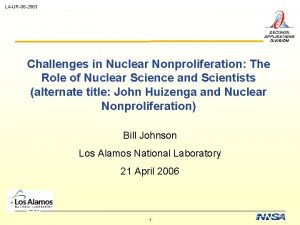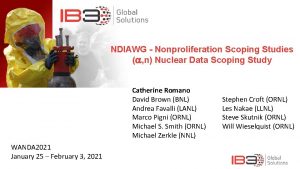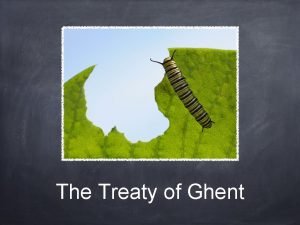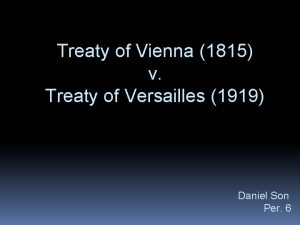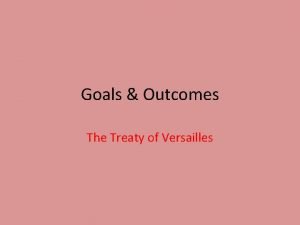NUCLEAR NONPROLIFERATION TREATY A REGIME IN NEED OF






















- Slides: 22

NUCLEAR NON-PROLIFERATION TREATY: A REGIME IN NEED OF INTENSIVE CARE International Organizations and Nonproliferation Program Center For Nonproliferation Studies 21 January 2003

NUCLEAR NON-PROLIFERATION TREATY: A REGIME IN NEED OF INTENSIVE CARE Course outline Part I : Overview of the nuclear nonproliferation regime Part II : The NPT • • • Overview of major developments in the NPT Challenges to the regime Will the regime survive?

WHAT IS NON-PROLIFERATION? Prevention of the spread of weapons of mass destruction (nuclear, chemical, biological) and their means of delivery* • Horizontal nuclear proliferation: spread of weapons to states not currently possessing nuclear weapons • Vertical nuclear proliferation: increase in number and destructiveness of nuclear weapons within a state already possessing them * Mostly applicable to nuclear weapons as biological and chemical weapons are banned

WHAT IS DISARMAMENT ? Total elimination of weapons of mass destruction, including nuclear weapons, through the prohibition on development, production and use and destruction of all such weapons

WHY IS NUCLEAR DISARMAMENT AND NONPROLIFERATION A PRIORITY?


30, 000 NUCLEAR WEAPONS Estimated 30 000 nuclear warheads worldwide 5 NPT nuclear weapons states (China, France, Russia, UK, USA) 3 states outside the NPT (India, Israel, Pakistan) North Korea, Iraq, Iran Others? Hiroshima: August 6, 1945 Nagasaki: August 9, 1945

NUCLEAR WEAPON DELIVERY SYSTEMS Delivery systems capable of delivering nuclear weapons • • Ballistic missiles Cruise missiles Artillery Rockets Submarines Aircraft Other

WHAT IS THE NUCLEAR NON PROLIFERATION AND DISARMAMENT REGIME? Collective term for international initiatives to prevent the spread of nuclear weapons leading to their total elimination

THE TREATY ON THE NONPROLIFERATION OF NUCLEAR WEAPONS Parties: 188 Non-parties: India, Israel, Pakistan A cornerstone of global security Embodies the international community's efforts to prevent the further spread of nuclear weapons and its aspirations for global disarmament, while also facilitating cooperation in the peaceful uses of nuclear energy under safeguards Entails commitments by both nuclear-weapon and nonnuclear-weapon states Verification of compliance with nonproliferation undertakings through the application of safeguards was conferred on the International Atomic Energy Agency (IAEA)

INTERNATIONAL ATOMIC ENERGY AGENCY (IAEA) Encourages & assists research, development and practical application of atomic energy for peaceful uses throughout the world Establishes & administers safeguards designed to ensure that the use of nuclear energy is not used for military purposes Applies safeguards to relevant activities at the request of Member States Applies mandatory comprehensive safeguards in NNWS to the NPT & other international treaties

IAEA SAFEGUARDS SYSTEM Continual monitoring of nuclear material to ensure it is not used for military purposes • extensive set of technical measures by which the IAEA Secretariat independently verifies the correctness and the completeness of the declarations made by States about their nuclear material and activities • confidence‑building tools of the nuclear nonproliferation regime. Why are safeguards important? Prevent the proliferation of nuclear weapons Foster the beneficial uses of atomic energy Provide confidence and build trust

INTERNATIONAL SAFEGUARDS: 3 key components Accountancy: reporting by states on the location of fissionable material under their control, on stocks of fuel and of spent fuel, on processig and reprocessing of nuclear materials, etc. Containment & Surveillance: techniques such as seals or video recording inside a facility Inspection: by IAEA inspectors, checking instrumetns and seals, verifying bookkeeping, confirming physical inventories of fuel or spent fuel

COMPREHENSIVE NUCLEAR TEST BAN TREATY Bans any nuclear weapon test explosion or any other nuclear explosion (true zero yield) Verification regime includes an international monitoring system (IMS) composed of seismological, radionuclide (16 laboratories), hydro acoustic and infrasound monitoring; consultation and clarification; on-site inspections; and confidence building measures Treaty provides for measures to redress a situation and to ensure compliance, including sanctions, and for settlement of disputes. Conference of State Parties or Executive Council can bring the issue to the attention of the United Nations

COMPREHENSIVE NUCLEAR TEST BAN TREATY ORGANIZATION Adopted by UNGA 9/24/1996 Signed by 165 State with 93 State Parties Entry into force requires ratification of 44 specific States with nuclear power capacities: 41 have signed - only 31 ratified Non-signatories include India, North Korea, and Pakistan The US (led the effort to conclude a CTBT and first to sign) and China, among those that have signed but not ratified U. S. Senate voted in 1999 not to ratify Global verification regime Worldwide network of 321 monitoring stations built & run by the host countries in cooperation with the (Provisional) Technical Secretariat (some 100 stations already transmit data to the International Data Center (IDC) in Vienna via satellite-based global communications infrastructure) On-site inspections and confidence-building measures Administrated by a (Provisional) Technical Secretariat

START I & II START I limits the total number of strategic nuclear delivery vehicles for the US and Russia to 1, 600 each, warheads to 6, 000 each, warheads mounted on ballistic missiles to 4, 900 each, warheads mounted on mobile ICBMs to 1, 100 each, and the total ballistic missile throw-weight for each party to 3, 600 metric tons (t) Bans the testing and development of certain types of ballistic missiles START II limits strategic weapons for each party, with reductions to be implemented in two phases: Phase I reduce total deployed strategic nuclear warheads to 3, 800 -4, 250 Phase II total number of deployed strategic nuclear warheads may not exceed 3, 000 -3, 500 Both US and Russia have ratified US declared withdrawal from ABM Treaty on 13 June followed by the Russian Federation announcement that it would withdrawal from the START II

NUCLEAR WEAPONS FREE ZONE TREATIES More than 110 states covered Antarctic Latin America and the Caribbean (Tlatelolco) South Pacific (Rarotonga) South Asia (Bangkok) Africa (Pelindaba) Mongolia Central Asia (? ) Middle East (? ) South East Asia (? )

UN SECURITY COUNCIL Promote the establishment and maintenance of international peace and security, including through disarmament and the establishment of a system for the regulation of armaments. 15 members: five permanent members: China, France, Russia, UK USA; and 10 non-permanent members Nonproliferation accomplishments: mandatory sanctions against Iraq Counter-Terrorism Committee exchanges information on the possession of WMD by terrorist groups responded to 1998 nuclear tests by India and Pakistan -- denied NWS status recognizing negative security assurances by the NWS in April 1995 urged all States to pursue in good faith effective measures relating to nuclear disarmament and on a treaty on general and complete disarmament under strict and effective international control declared the proliferation of all WMD constitutes a threat to international peace and security Organs established by the UNSC: Monitoring, Verification and Inspection Commission (UNMOVIC): a reinforced, ongoing monitoring and verification system to ensure Iraqi compliance with Security Council resolutions Undertake the responsibilities of the former (UNSCOM) Special Commission on Iraq (UNSCOM): Established for the purposes of eliminating Iraq’s capabilities vis-à-vis WMD and ballistic missiles

PART II THE TREATY ON THE NONPROLIFERATION OF NUCLEAR WEAPONS (NPT)

The Treaty on the Non-Proliferation of Nuclear Weapons (NPT) Opened for signature on June 12, 1968, signed by 62 states including 3 depositary governments (US, USSR, UK) UN General Assembly approved NPT text on March 11, 1968 Entered into force: 1970 Extended indefinitely: 1995

THE NPT: A DEAL BETWEEN THE “HAVES” AND THE “HAVE-NOTS” Nuclear Weapon States (NWS) – (China, France, the Russian Federation, the United Kingdom, and the United States): • may retain their nuclear arsenals; • may not transfer nuclear weapons to any one; • may not assist any NNWS to acquire, manufacture or control nuclear weapons; and • commit to pursuing negotiations in good faith towards ending the nuclear arms race and achieving nuclear disarmament. Non-Nuclear Weapon States (NNWS) – (defined as those ( states that had not detonated a nuclear device prior to January 1, 1967) • must not build, acquire or possess nuclear weapons; • may research, produce, and use nuclear energy for peaceful purposes; and • must accept safeguards (audits and intrusive on-site monitoring) on all of their nuclear activities and materials to verify they are not being used for nuclear weapons.

CONCLUSION Security cannot be achieved through the continued reliance on nuclear weapons, but only through international cooperation in developing and maintaining effective, binding, and verifiable multilateral agreements such as embodied in the NPT and the CTBT Vertical and horizontal proliferation should be given equal priority Fulfillment of NWS commitments is integral to maintaining the NPT itself - if NNWS are to be convinced of the continuing value of not pursuing nuclear weapons and staying within the NPT, they will need to be convinced that the NNWS are taking active steps towards eliminating their nuclear arsenals and decreasing rather than increasing the changes of these weapons being used If the NWS fail to adequately address these concerns, the nuclear nonproliferation regime may be unraveling by the time the 2005 NPT Review Conference convenes - litmus test for undertakings given in 1995 and 2000
 Lesson 15 nuclear quest nuclear reactions
Lesson 15 nuclear quest nuclear reactions Fisión nuclear vs fision nuclear
Fisión nuclear vs fision nuclear Mass flow fermenter
Mass flow fermenter Regime jenny gray
Regime jenny gray Schéma de liaison it
Schéma de liaison it Carte mentale urss de staline
Carte mentale urss de staline Regime diferenciado disciplinar
Regime diferenciado disciplinar Regime permanente senoidal
Regime permanente senoidal Legal regime
Legal regime Propagande vichy
Propagande vichy The flexible exchange rate regime 1973-present
The flexible exchange rate regime 1973-present Regime de competencia
Regime de competencia Tableau régime alimentaire sous avk
Tableau régime alimentaire sous avk Self contained regime
Self contained regime Guinier regime
Guinier regime Sconto razionale formule inverse
Sconto razionale formule inverse Regime sinusoidale
Regime sinusoidale The ancien regime
The ancien regime Fluidos
Fluidos What is a situational analysis in first aid
What is a situational analysis in first aid Old regime 3 estates
Old regime 3 estates Regime du neutre
Regime du neutre Marsalis v. la salle
Marsalis v. la salle


